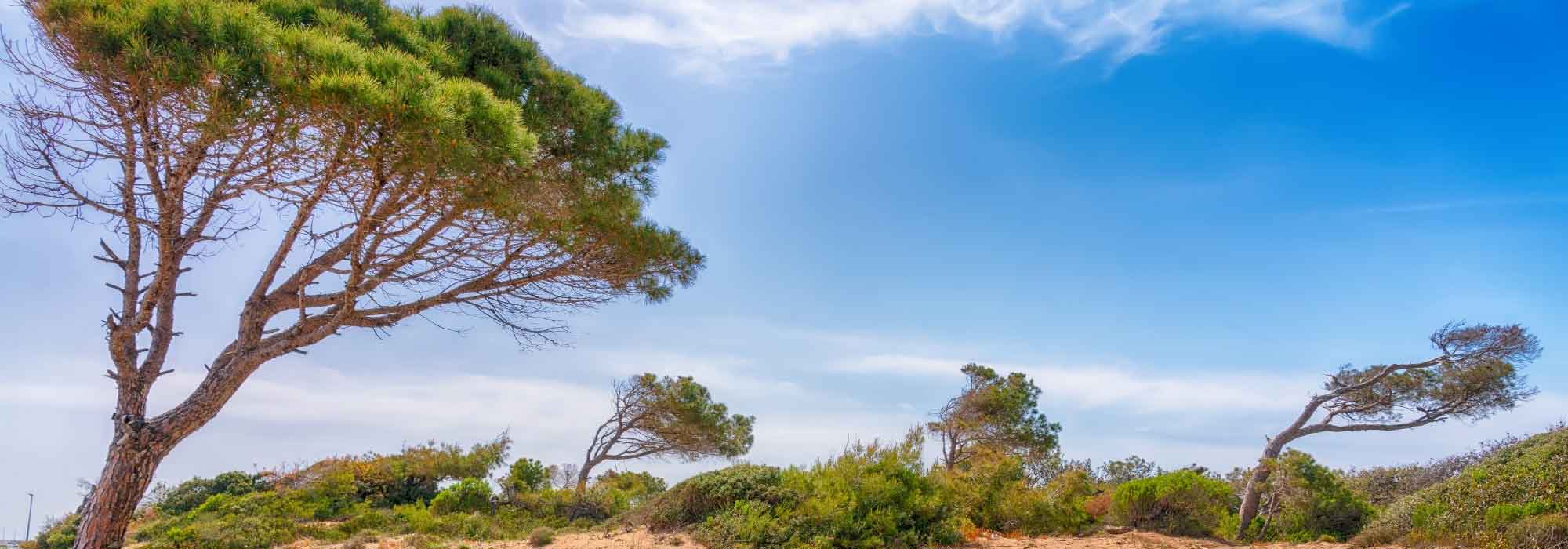
Planting in a garden exposed to the Mistral or Tramontane winds
All our tips for gardening in the wind
Contents
They sweep everything in their path… Mistral, Tramontane, Cers, these winds shake the branches, bend people, dry out the soil and the plants. They are cold winds blowing from the North-Northwest towards the south across a large part of our Mediterranean coastline. Bringing icy cold in winter and scorching heat in summer, they play an important role in the dehydration of plants, exacerbating living conditions already made difficult by sunlight and poor soils. Gardening in these conditions is not easy; discover how to plant in a garden exposed to the Mistral or Tramontane.
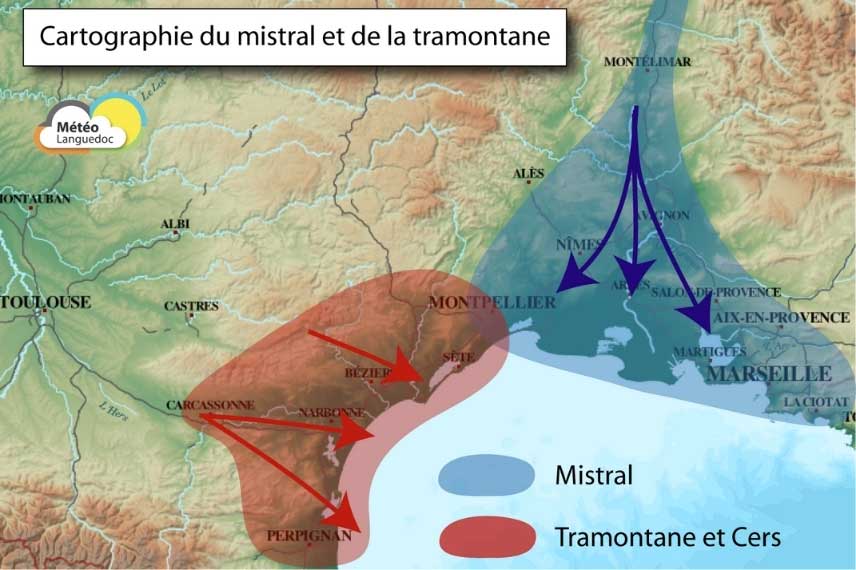
Areas of influence of the Mistral and Tramontane (meteolanguedoc.com)
The adaptation strategies of plants to the Mistral and Tramontane winds
Mediterranean vegetation is constantly subjected to these harsh living conditions. However, it harbours great richness: over 60% of species on less than 10% of French territory. Over time, these plants have adapted and now exhibit characteristics resulting from this adaptation:
- Many evergreen Mediterranean plants are sclerophyllous, meaning “with hard leaves.” The upper side of the leaves is leathery to limit evapotranspiration, while the underside, less exposed, is different and contains the stomata (small openings allowing gas exchange) that ensure photosynthesis.
- Another adaptation is the reduction of leaf surface area. Foliage is small or linear, resembling needles. Think of thyme, rosemary, or lavender.
- The very morphology of certain plants allows them to adapt: the rounded cushion shape enables some to fold in on themselves and maximally protect their stems and leaf surface from the wind. Also, the fleshy leaves of succulents like sedums, and the spiralled arrangement of leaves in some euphorbias.
- Have you ever observed the leaves of Stachys byzantina, Ballota, or Jerusalem Sage? These plants have downy leaves, covered in hairs that help insulate them from drying winds and sunlight.
- Mediterranean plants, known for their aromatic richness, also envelop themselves in a bubble of fresh air thanks to the essential oils they contain.
- Finally, an adapted and complex root system, particularly a long taproot, allows them to anchor in the soil to withstand the wind and reach water and nutrients deep down.
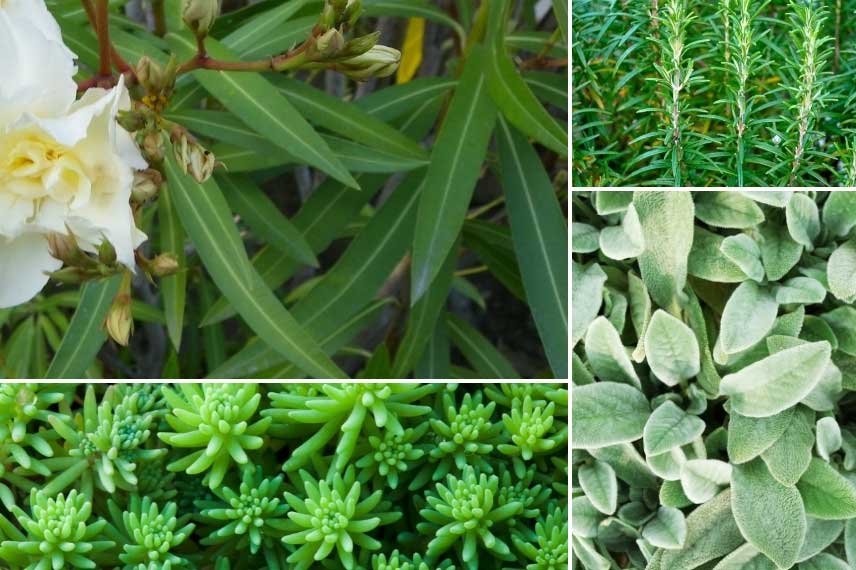
Adaptation of plant leaves to sun and wind: leathery in Oleander, fine in rosemary, succulent in Sedum, and hairy in Stachys byzantina
Read also
How and why to create a windbreak hedge?Choosing suitable plants
Many trees, bushes, and perennials can create stunning gardens exposed to the Mistral or Tramontane winds. Observe what Mother Nature does; she has many answers for planting in a windy garden. What do you see growing in the landscapes around you? Pines, rosemary, cistus, strawberry trees? So forget about hydrangeas or Japanese maples; they won’t survive! Instead, adapt your plantings to the local plant palette. If that doesn’t fully satisfy you, know that different parts of the globe have a climate described as “Mediterranean,” meaning they offer similar weather conditions and are potentially subject to cold, intense winds: in Chile, California, South Africa, Australia, and of course, around the Mediterranean Basin. Plants from these areas can therefore be used in your garden. The highly floriferous Polygala myrtifolia and the very easy Euryops pectinatus come from South Africa, the Fremontodendron californicum with its magnificent flowering hails from California, while Callistemon and Grevillea come from Australia. Not to mention the laurustinus and the holm oak that grow spontaneously in the Mediterranean landscapes and are very resistant to the wind. It is important, when choosing your plants, to check their origin to ensure they will adapt to your planting conditions.
Planting windbreaks to encourage the creation of a micro-climate
Gardening in areas subjected to these “mad winds” can sometimes be a daunting task. By adopting the right reflexes and making the right gestures, conditions can improve, allowing for the creation of a favourable microclimate that makes the garden a pleasant place to be. The first thing for the gardener to do is to filter the passage of wind by creating windbreak hedges. To avoid excessive opacity, it is generally advisable to plant 2/3 evergreen plants and 1/3 deciduous plants, reversing the usual ratio for diversified hedges, as the aim here is to create a protective screen. The windbreak can shield from gusts over a distance proportional to about 10 times its height, so 1 m of hedge can protect an area of 10 m behind it. Conversely, a brick wall will reinforce the wind that passes over it and create gusts as it “falls” behind. The idea is to plant a rather thick hedge, ideally staggering the plants. If it is on a property boundary, it will need to be pruned to maintain its height below 2 m.
For these windbreak hedges, you might choose:
- Arundo donax – The giant reed, taking care with its invasive growth
- Atriplex canescens with grey foliage
- Eleagnus ebbingei – The well-known oleaster or Elaeagnus ebbingei ‘Limelight’, a very bright variegated variety
- Ligustrum ovalifolium – The privet, very easy to grow and fast-growing, along with the beautiful golden privet Ligustrum ovalifolium ‘Aureum’
- Prunus lusitanica – The Portuguese laurel
- Spartium junceum – The Spanish broom, which grows very quickly and forms windbreaks rapidly
- Tamarix ramosissima ‘Pink Cascade’ – The summer tamarisk with beautiful feathery flowers
- Teucrium fruticans ‘Azureum’ – The germander, which flowers from February to June
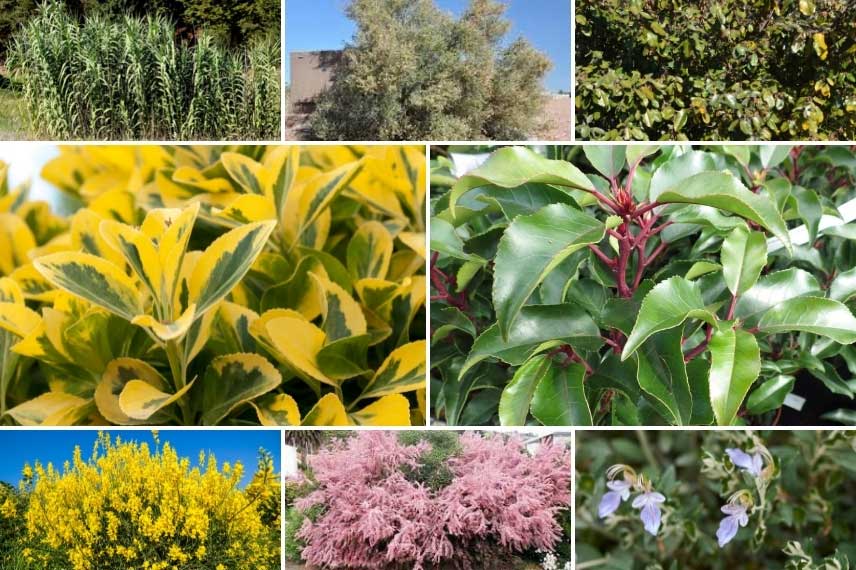
Arundo donax, Eleagnus ebbingei, Eleagnus ebbingei, Ligustrum ovalifolium ‘Aureum’, Prunus lusitanica, Spartium junceum in bloom from May to June, Tamarix ramosissima ‘Pink Cascade’ in bloom from July to September and Teucrium fruticans ‘Azureum’ in bloom from February to June
Planting trees
Planting leafy trees and conifers also helps create a screen that filters the wind and slows down air currents. They naturally complement windbreak hedges. Observe the direction of the prevailing wind before planting them, and if possible, create groves to enhance their effect. Ideally, choose young plants that will root well and grow more easily, and favour evergreens. In sheltered gardens, you can choose without hesitation:
- Arbutus unedo – Strawberry tree
- Cupressus sempervirens ‘Pyramidalis’ – Provence cypress
- Chamaecyparis lawsoniana ‘Elwoodii’ – Lawson cypress
- Celtis australis – Mediterranean hackberry
- Quercus ilex – Holm oak
- Trachycarpus fortunei – Chinese windmill palm, perfectly hardy
- Olea europea – Olive tree
- Pinus alepensis – Aleppo pine, suitable for large gardens and should be planted away from buildings
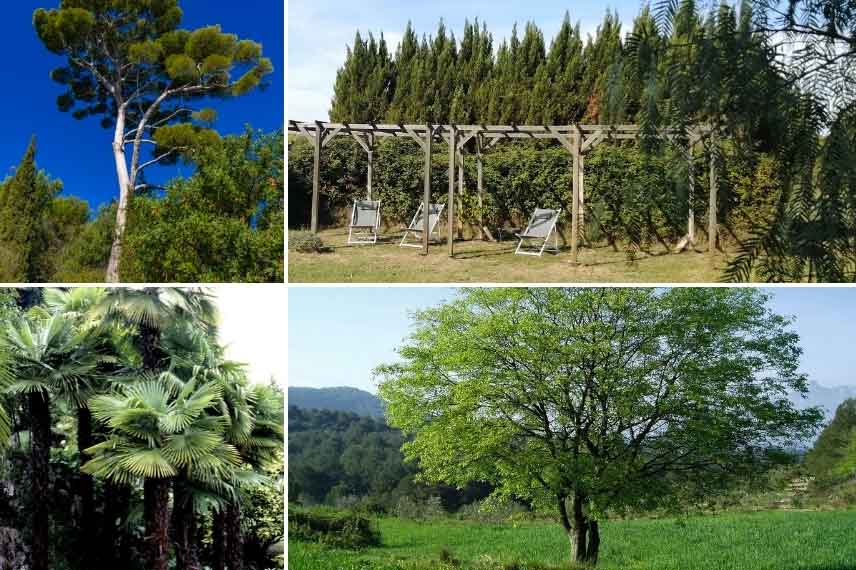
Pinus alepensis, Cupressus sempervirens planted in a high windbreak hedge, “grove” of Trachycarpus fortunei and Celtis australis
Scatter cushions throughout the garden.
For borders, prefer plants with a rounded or cushion habit, such as:
- the lovely Ballota with its fluffy leaves
- the Pittosporum tenuifolium ‘Golf ball’ and Pittosporum tobira ‘Nanum’
- the Osteospermum groundcover
- the Artemisia abrotanum
- the Cistus
- the Euphorbias: pythiusa, characias ssp. ‘Wulfenii’, …
- the Helichrysum italicum
- the Lavenders
- the Myrsine africana
- the Santolines
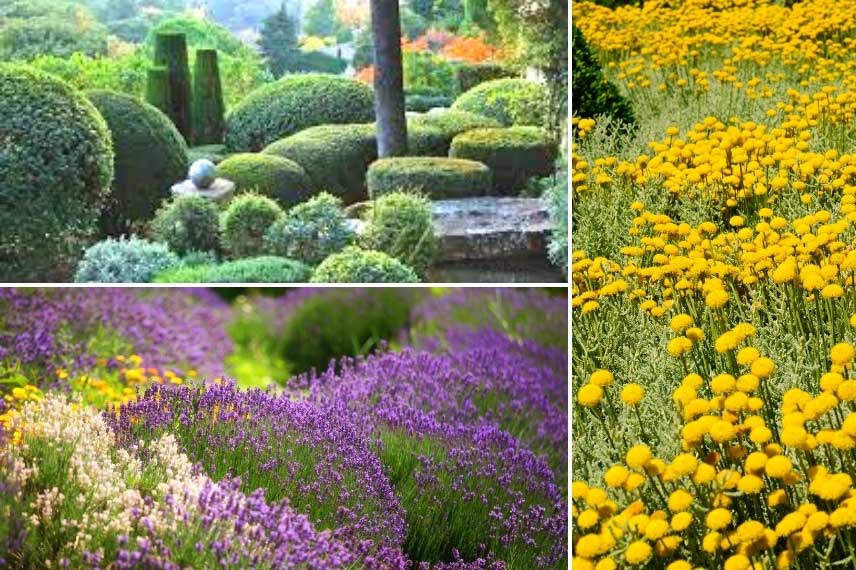
Plants with cushion or ball shapes withstand the Mistral and Tramontane admirably well
Combine in your outdoor compositions with robust shrubs such as:
- the Callistemon – Bottlebrush
- the Cotinus – Smoke tree
- the Coronilla glauca
- the Phlomis – Jerusalem sage
- the Nerium oleander – Oleander
- the Viburnum tinus – Laurustinus
- the Vitex agnus-castus – Chaste tree
- the Myrtus communis ‘Tarentina’ – Myrtle
- the Rosmarinus – Rosemary
If strategic areas of the garden, such as the terrace or poolside, are exposed to unbearable winds, do not hesitate to isolate them in a cocoon of greenery made up of these shrubs, pruned or not, and these perennials. You will enjoy a softer atmosphere and the flowering of the plants!
Adopt the tough ones
In addition, feel free to adopt tough plants with resilient foliage that the wind cannot lacerate. The Yucca (Filamentosa, rostrata…), Agaves, Cycas revoluta, Hesperaloe parvifolia, Opuntia, or Dasylirion are not afraid of the wind and give the garden an exotic look. However, be cautious of the invasive nature of some agaves. If their spiky appearance makes you hesitate, simply place them a bit further back in the beds to prevent both young and old from brushing against them… and getting pricked!
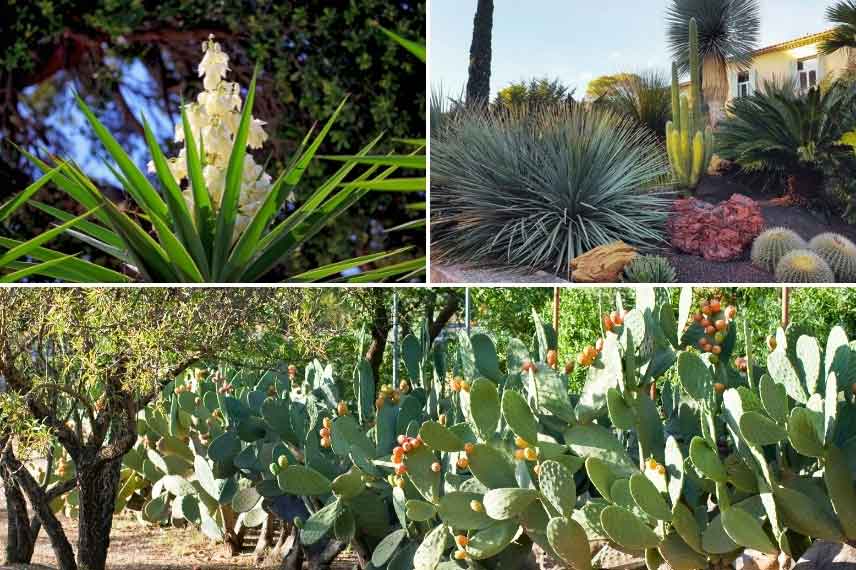
Yucca in bloom, a bed of Cycas revoluta, Dasylirion, and cacti, with the pads of Opuntia below
Water deeply / Mulch / Stake
When planting and maintaining your garden, make sure to adopt the right practices that will make a difference:
- Shallow watering leads to shallow rooting, while deep watering encourages deep rooting! It is essential to create a significant basin around the planting hole to retain watering water and prevent it from running off across the soil. Water deeply and infrequently.
- Mulch the base of hedges (organic mulch), as wind dries out the soil and depletes it by eroding it. This will facilitate the establishment and growth of bushes.
- Staking trees is also crucial, especially in windy conditions. It will prevent the root ball from moving and allow for quicker and more effective rooting. Depending on the size of the planted subjects and their exposure to wind, you can use simple, bipod, or tripod staking. Use rubber ties designed for this purpose, not just string or wire, which can damage the tree.
- A temporary protection using a windbreak screen can be helpful to encourage the growth of hedge shrubs or flower beds by sheltering them during the first seasons.
- Subscribe!
- Contents































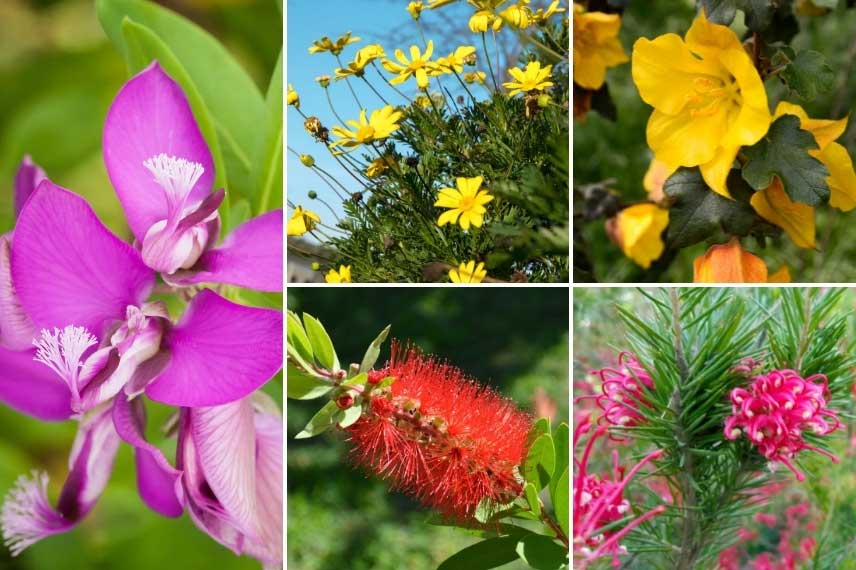
Comments